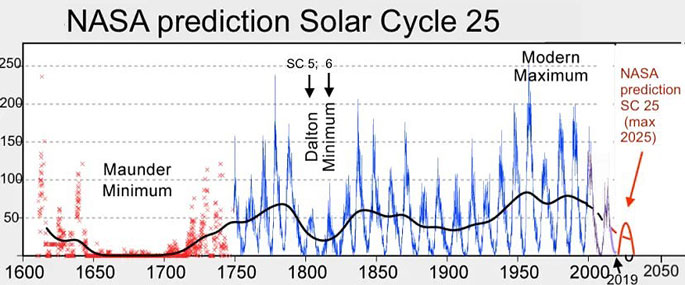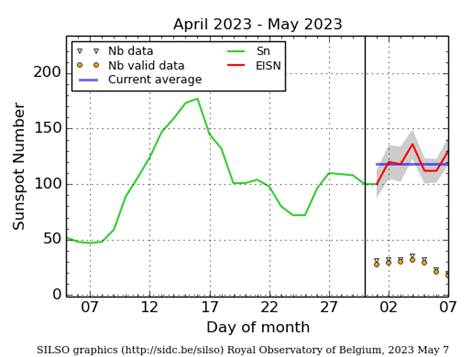 |
Weather Eye with |
The ‘Maunder Minimum' is the name given to the period from 1645 to 1715 when the number of sunspots – ‘storms' on the sun – became almost zero.
The period is named after the solar astronomer Edward Walter Maunder (1851-1928), who was working at The Royal Observatory at Greenwich when he discovered the dearth of sunspots during this period.
During one 30-year period within the Maunder Minimum there were only about 50 sunspots compared with a more typical 40,000. Maunder was a driving force in the foundation of the British Astronomical Association and a Fellow of the Royal Astronomical Society.
The sun was well observed during the period of the Maunder Minimum and this lack of sunspots is well documented. This period of solar inactivity corresponded to a climatic period called the ‘Little Ice Age' when in Europe rivers that were normally ice-free, froze and snow fields remained at low altitudes throughout the year.
There is evidence the sun had similar periods of inactivity during the years 1100-1250 and 1460-1550. Sunspots generally follow a cycle of about 11 years, but cycles have varied from eight-15 years. The connection between solar activity and the earth's climate is an area of ongoing and sometimes controversial research.
Sunspot groups that are clearly visible and observed by designated ground-based observatories, are classified by NOAA , by a NOAA/SWPC 4-digit region number to officially record and track the sunspot group as it rotates across the visible solar disk. Sunspot groups are analyzed and characterized based on their size and complexity by SWPC forecasters each day using the modified Zurich classification scale and Mount Wilson magnetic classification system. This daily sunspot analysis and classification is submitted at the end of each UTC-day as the Solar Region Summary report.
Sunspots can change continuously and may last for only a few hours to days; or even months for the more intense groups. The total number of sunspots has long been known to vary with an approximately 11-year repetition known as the solar cycle. The peak of sunspot activity is known as solar maximum and the lull is known as solar minimum. Solar cycles started being assigned consecutive numbers. This number assignment began with solar cycle 1 in 1755 and the most recent being cycle 24 – which began in December, 2008 and is now nearing solar minimum. A new solar cycle is considered to have begun when sunspot groups emerge at higher latitudes with the magnetic polarities of the leading spots opposite that of the previous cycle.
A plot of sunspot number progression for the previous and current solar cycle, and that compares the observed and smoothed values with the official sunspot number forecast provided by the Solar Cycle Prediction Panel representing NOAA, the International Space Environmental Services (ISES), and NASA is available to view on our SWPC webpage at solar cycle progression.
The official daily and monthly sunspot numbers are determined by the World Data Center – Sunspot Index and Long-term Solar Observations (WDC-SILSO(link is external)) at the Royal Observatory of Belgium. Generally, sunspot reports from observatories calculate sunspot numbers whereby each sunspot group counts as 10, and every umbra within each spot group is individually considered as 1. Therefore, no sunspots on the visible Sun would be considered as zero; while the next possible number can only be 11 or higher.
More detailed information about sunspot number concepts and a thorough perspective about the solar cycle, can be learned by reading the scientific paper: “Revisiting the Sunspot Number, a 400-year perspective on the Solar Cycle” by F. Clette, L. Svalgaard, J. Vaquero, and E. Cliver; Space Sci Rev (2014) 186:35-103; DOI 10.1007/s11214-014-0074-2

The above chart and the following comment is from NASA's official website (www.nasa.gov).
Two spacecraft are currently directly observing the Sun: NASA's Parker Solar Probe (which will eventually approach to just 5% of the Earth-Sun distance), and ESA's Solar Orbiter, which is en route to observe the Sun's poles. Hopefully one day we will have a better picture of the processes involved in sunspots and the Solar cycle.
The sunspot number for most days during the last three months is about 150.


A sunspot is a relatively dark, sharply defined region on the solar disc – marked by an umbra, dark area, which is 2000 degrees cooler than the effective photospheric temperature. The average diameter of a sunspot is 4000 km, but they can exceed 200,000 km.
Sunspots are temporary phenomena on the Sun's photosphere that appear as spots darker than the surrounding areas. They are regions of reduced surface temperature caused by concentrations of magnetic field flux that inhibit convection. Sunspots usually appear in pairs of opposite magnetic polarity. Individual sunspots or groups of sunspots may last anywhere from a few days to a few months, but eventually decay.
The NASA solar physics website, and other websites such as the Royal Observatory of Belgium, include information on sunspot numbers, the ‘Maunder Minimum' and sunspot cycle predictions.
The sunspot index is updated monthly and available from 1749.



Time will tell whether the sun will once again go into another ‘Maunder Minimum' within the lifetime of the present generation, but if this happens we're likely to have a much colder climate for a few decades.
*************************************************
For further information on a range of weather and climate matters see my recent book "Climate Change: A Realistic Perspective.. The fall of the weather dice and the butterfly effect" . Available from Amazon.au.

